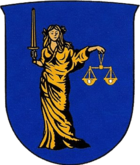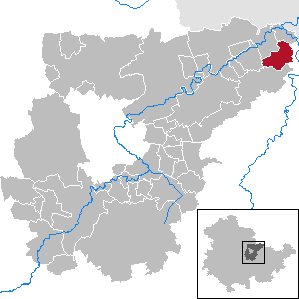Blacksmiths
| coat of arms | Germany map | |
|---|---|---|

|
Coordinates: 51 ° 4 ′ N , 11 ° 40 ′ E |
|
| Basic data | ||
| State : | Thuringia | |
| County : | Weimar Country | |
| Fulfilling municipality : | Bad Sulza | |
| Height : | 225 m above sea level NHN | |
| Area : | 10.38 km 2 | |
| Residents: | 364 (Dec. 31, 2019) | |
| Population density : | 35 inhabitants per km 2 | |
| Postal code : | 99518 | |
| Area code : | 036421 | |
| License plate : | AP, APD | |
| Community key : | 16 0 71 083 | |
| Address of the municipal administration: |
Dorfstrasse 21 99518 Schmiedehausen |
|
| Website : | ||
| Mayor : | Bernd Otterstein | |
| Location of the community Schmiedehausen in the Weimarer Land district | ||
Schmiedehausen is a municipality in the northeast of the Weimarer Land district . The fulfilling municipality is the city of Bad Sulza .
geography
Schmiedehausen is located in the extreme north-eastern corner of the Saale-Ilm limestone slab and can be easily reached via Camburg and Bad Sulza via the state road 2158 . The district of the place is arable developed. The wooded heights of the Ilm Valley begin at Bergsulza .
history
Schmiedehausen was first mentioned in a document in 1166 by the nobleman Rupert de Smidehusen. The oldest population register comes from the first third of the 15th century. The place belonged to the Wettin office of Camburg , which was under the sovereignty of various Ernestine duchies due to several divisions in the course of its existence . In 1826 Schmiedehausen came from the Duchy of Saxony-Gotha-Altenburg to the Duchy of Saxony-Meiningen as part of the Camburg exclave . From 1922 to 1939 the place belonged to the Camburg district department .
At the former brickworks, a younger Bronze Age depot was found with two bronze neck rings, three bronze arm rings and the cheek flap of a helmet. Cultic reasons for defeat are likely.
Lachstedt is a district of Schmiedehausen.
religion
Christianity has prevailed in the area since the High Middle Ages. One can assume that the inhabitants of the place mentioned for the first time in the 12th century were predominantly Christians. In 1219 Margrave Dietrich subordinated the church to his newly founded nunnery in Eisenberg, where it remained until the Reformation. There is evidence of a parish since the 14th century. In 1539 the Reformation was carried out in Schmiedehausen. The previously Roman Catholic Church was converted into an Evangelical Lutheran. According to canon law, the parish belonged to the Archdiocese of Mainz, including the archdeacon Beatae Mariae Virginis in Erfurt and the deanery Utenbach. From there the pastors were appointed. The first Protestant pastor is proven as early as 1539. As a result, the pastors were appointed by the sovereign. The commander, which existed next to the main altar, was converted into a community foundation. Until the 20th century, only Evangelical Lutheran. To meet believers. Simultaneously with the influx of Catholics. There was also a secularization of faith. Especially after 1945 there were church resignations, which in 1990 had another high point with the introduction of the state-organized collection of church taxes. In 2011, 33% of the inhabitants of Schmiedehausen were Protestant and 2% Catholic. The village churches Schmiedehausen and Lachstedt belong to the parish "Lachstedt bis Eckolstädt " in the parish of Dorndorf / Saale , which in turn belongs to the Eisenberg parish of the Evangelical Church in Central Germany . The few Catholics are assigned to the parish of St. Johannes Baptist in Jena , Diocese of Erfurt , whose next branch church is St. Marien in Camburg .
Attractions
- Church with furnishings, churchyard formerly used as a cemetery, bell house and war memorial for the fallen of both world wars from the town
- Tower windmill, in need of renovation
- Several stately, listed farmsteads, some with portals, gates, courtyard walls and inscriptions.
societies
- SV Blau-Weiß Schmiedehausen 1950 eV Organizes regular football tournaments.
- Club Birkenwald eV
- Boys Society 1828 eV
- Schmiedehausen volunteer fire department
regional customs
- Pentecost with birch trees
- Blacksmiths' Cherry Festival: Introduced for the children in 1920 by the pastor at the time (there were numerous cherry plantations around the village at that time); Village festival on the green meadow, always on the last Sunday in June - during cherry season
Individual evidence
- ^ Population of the municipalities from the Thuringian State Office for Statistics ( help on this ).
- ^ Otto Dobencker : Regesta diplomatica necnon epistolaria historiae Thuringiae. Volume 2: (1152-1227). Gustav Fischer, Jena 1900, p. 159 f., No. 843 .
- ^ Andrei Zahn: The inhabitants of the offices of Burgau, Camburg and Dornburg. A prayer register from around 1421–1425 (= AMF series of publications. 55, ZDB -ID 2380765-9 ). Printed as a manuscript. Working Group for Central German Family Research, Mannheim 1998.
- ↑ Michael Köhler : Pagan sanctuaries. Pre-Christian places of worship and suspected cult sites in Thuringia. Jenzig-Verlag Köhler, Jena 2007, ISBN 978-3-910141-85-8 , p. 232.
- ^ Parish book of Saxony-Altenburg [1]
- ↑ census database




